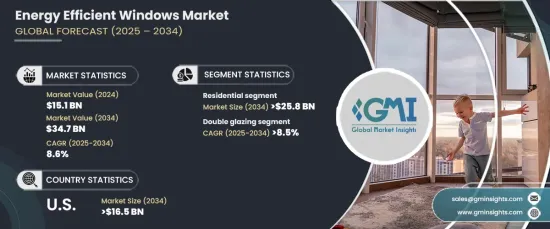
|
시장보고서
상품코드
1667086
세계의 에너지 절약형 창문 시장 기회, 성장 촉진요인, 산업 동향 분석 및 예측(2025-2034년)Energy Efficient Windows Market Opportunity, Growth Drivers, Industry Trend Analysis, and Forecast 2025 - 2034 |
||||||
에너지 절약형 창문 세계 시장은 2024년에 151억 달러로 평가되었고, 2025-2034년 연평균 8.6%의 성장률을 보일 것으로 예상됩니다. 이 창은 건물의 열 성능을 향상시키고 에너지 손실을 최소화하도록 설계되었습니다. 실내외 열교환을 줄임으로써 냉난방 비용을 낮추는 동시에 온실 가스 배출을 줄여 지속 가능한 에너지 관행을 지원합니다.

에너지 절약에 대한 관심 증가와 탄소 발자국 감소에 대한 인식이 높아지면서 에너지 효율이 높은 창호 채택을 촉진하는 주요 요인으로 작용하고 있습니다. 아시아태평양에서는 인프라 투자 증가와 건설 활동 확대가 시장 성장을 가속할 것으로 예상됩니다. 또한, 에너지 절약을 위한 엄격한 규제로 인해 에너지 효율이 높은 솔루션으로의 전환이 수요를 더욱 촉진하고 있습니다.
| 시장 범위 | |
|---|---|
| 시작 연도 | 2024년 |
| 예측 연도 | 2025-2034년 |
| 시작 금액 | 151억 달러 |
| 예상 금액 | 347억 달러 |
| CAGR | 8.6% |
시장은 주거 및 상업 분야 모두에서 에너지 절약의 중요성에 대한 인식이 높아짐에 따라 혜택을 누리고 있습니다. 많은 부동산 소유주들은 냉난방 비용을 절감하기 위해 단열성을 높이고 에너지 사용량을 줄이는 창문을 선택하고 있습니다. 각국 정부는 세제 혜택과 인증을 통해 현대식 창호 디자인을 포함한 에너지 효율이 높은 건축자재 사용을 장려함으로써 이러한 변화를 촉진하고 있습니다.
용도별로는 주택 분야는 2034년까지 258억 달러 이상에 달할 것으로 예상됩니다. 건설 활동 증가와 주택 소유주들의 에너지 절약 솔루션에 대한 선호도가 높아지면서 수요가 증가하고 있습니다. 소비자들은 온도 변동을 줄이고, 냉난방과 통풍을 통해 쾌적성을 높여주는 제품을 선호하고 있으며, 이는 가정의 에너지 효율을 개선하는 데 기여하고 있습니다. 또한, 오래된 부동산을 최신 에너지 기준에 맞게 업그레이드하는 추세도 이 부문의 성장을 더욱 촉진하고 있습니다.
글레이징 유형에 따른 이중창 부문은 2034년까지 8.5% 이상의 CAGR로 크게 확대될 것으로 예상됩니다. 열전도를 제한하고 실내 온도를 유지하도록 설계된 이 창은 비용 절감과 쾌적성 향상이라는 장점으로 인기를 끌고 있습니다. 글레이징 기술의 발전은 이러한 제품의 효율성과 내구성을 더욱 향상시켜 다양한 분야에서의 채택을 촉진하고 있습니다.
미국에서는 2034년까지 에너지 효율이 높은 창호 시장이 165억 달러를 넘어설 것으로 예상됩니다. 에너지 비용 증가와 지속 가능한 건축 관행에 대한 관심 증가가 수요를 촉진하는 주요 요인으로 작용하고 있습니다. 이 시장은 또한 에너지 효율이 높은 솔루션을 장려하는 정부 이니셔티브의 혜택을 받고 있으며, 환경 문제를 해결하면서 유틸리티 비용을 절감하는 데 도움이 되고 있습니다.
목차
제1장 조사 방법과 조사 범위
- 시장의 정의
- 기본 추정과 계산
- 예측 계산
- 1차 조사와 검증
- 1차 정보
- 데이터 마이닝 소스
- 시장 정의
제2장 주요 요약
제3장 업계 인사이트
- 업계 에코시스템
- 규제 상황
- 업계에 대한 영향요인
- 성장 촉진요인
- 업계의 잠재적 리스크&과제
- 성장 가능성 분석
- Porter의 Five Forces 분석
- 공급 기업의 교섭력
- 바이어의 교섭력
- 신규 진출업체의 위협
- 대체품의 위협
- PESTEL 분석
제4장 경쟁 구도
- 서론
- 전략 대시보드
- 혁신 및 기술 전망
제5장 시장 규모와 예측 : 글레이징 유형별, 2021년-2034년
- 주요 동향
- Double glazing
- Triple Low-E glazing
제6장 시장 규모와 예측 : 채택별, 2021년-2034년
- 주요 동향
- 교환
- 단열
제7장 시장 규모와 예측 : 창수별, 2021년-2034년
- 주요 동향
- 6개까지
- 6-10개 이상
- 10개 이상
제8장 시장 규모와 예측 : 용도별, 2021년-2034년
- 주요 동향
- 주택
- 상업
제9장 시장 규모와 예측 : 지역별, 2021년-2034년
- 주요 동향
- 북미
- 미국
- 캐나다
- 유럽
- 독일
- 영국
- 프랑스
- 이탈리아
- 아시아태평양
- 중국
- 일본
- 호주
- 세계 기타 지역
제10장 기업 개요
- Atrium Corporation
- AeroShield
- Andersen Corporation
- Builders First Choice
- Jeld-Wen
- Kolbe Windows
- Marvin Windows &Doors
- Milgard Manufacturing
- Pella Corporation
- PGT Windows
- Simonton Windows
- Soft-Lite Windows
- YKK AP
The Global Energy Efficient Windows Market, valued at USD 15.1 billion in 2024, is projected to grow at a CAGR of 8.6% from 2025 to 2034. These windows are engineered to enhance thermal performance and minimize energy loss in buildings. By reducing heat exchange between indoor and outdoor environments, they help lower heating and cooling costs while supporting sustainable energy practices by cutting greenhouse gas emissions.

The increasing focus on energy conservation and the growing awareness about carbon footprint reduction are key factors driving the adoption of energy efficient windows. In regions like Asia Pacific, rising infrastructure investments and expanding construction activities are expected to boost market growth. Additionally, the shift towards energy-efficient solutions, driven by stringent regulations for energy conservation, is further propelling demand.
| Market Scope | |
|---|---|
| Start Year | 2024 |
| Forecast Year | 2025-2034 |
| Start Value | $15.1 Billion |
| Forecast Value | $34.7 Billion |
| CAGR | 8.6% |
The market is also benefiting from heightened awareness about the importance of energy conservation in both residential and commercial sectors. Many property owners opt for windows that enhance thermal insulation and reduce energy use, driven by the need to control heating and cooling expenses. Governments worldwide are encouraging this shift by offering tax incentives and certifications to promote the use of advanced energy-efficient building materials, including modern window designs.
In terms of application, the residential segment is forecasted to surpass USD 25.8 billion by 2034. The rise in construction activities and a growing preference for energy-saving solutions among homeowners fuel demand. Consumers are increasingly prioritizing products that enhance comfort by reducing temperature fluctuations and eliminating drafts, contributing to improved energy efficiency in households. Additionally, the trend of upgrading older properties to meet modern energy standards is further supporting the segment's growth.
The double glazing segment, based on glazing type, is anticipated to witness significant expansion, with a CAGR exceeding 8.5% through 2034. These windows, designed to limit heat transfer and maintain indoor temperatures, are gaining popularity due to their cost-saving and comfort-enhancing benefits. Advances in glazing technologies further enhance the efficiency and durability of these products, bolstering their adoption across various sectors.
In the U.S., the energy efficient windows market is expected to exceed USD 16.5 billion by 2034. Growing energy costs and increasing emphasis on sustainable building practices are key factors driving demand. The market also benefits from government initiatives promoting energy-efficient solutions, helping to reduce utility costs while addressing environmental concerns.
Table of Contents
Chapter 1 Methodology & Scope
- 1.1 Market definitions
- 1.2 Base estimates & calculations
- 1.3 Forecast calculation
- 1.4 Primary research & validation
- 1.4.1 Primary sources
- 1.4.2 Data mining sources
- 1.5 Market definitions
Chapter 2 Executive Summary
- 2.1 Industry synopsis, 2021 – 2034
Chapter 3 Industry Insights
- 3.1 Industry ecosystem
- 3.2 Regulatory landscape
- 3.3 Industry impact forces
- 3.3.1 Growth drivers
- 3.3.2 Industry pitfalls & challenges
- 3.4 Growth potential analysis
- 3.5 Porter's analysis
- 3.5.1 Bargaining power of suppliers
- 3.5.2 Bargaining power of buyers
- 3.5.3 Threat of new entrants
- 3.5.4 Threat of substitutes
- 3.6 PESTEL analysis
Chapter 4 Competitive landscape, 2024
- 4.1 Introduction
- 4.2 Strategic dashboard
- 4.3 Innovation & technology landscape
Chapter 5 Market Size and Forecast, By Glazing Type, 2021 – 2034 (USD Billion)
- 5.1 Key trends
- 5.2 Double glazing
- 5.3 Triple Low-E glazing
Chapter 6 Market Size and Forecast, By Adoption, 2021 – 2034 (USD Billion)
- 6.1 Key trends
- 6.2 Replacement
- 6.3 Insulation
Chapter 7 Market Size and Forecast, By Number of Windows, 2021 – 2034 (USD Billion)
- 7.1 Key trends
- 7.2 Up to 6 units
- 7.3 >6 to 10 units
- 7.4 >10 units
Chapter 8 Market Size and Forecast, By Application, 2021 – 2034 (USD Billion)
- 8.1 Key trends
- 8.2 Residential
- 8.3 Commercial
Chapter 9 Market Size and Forecast, By Region, 2021 – 2034 (USD Billion)
- 9.1 Key trends
- 9.2 North America
- 9.2.1 U.S.
- 9.2.2 Canada
- 9.3 Europe
- 9.3.1 Germany
- 9.3.2 UK
- 9.3.3 France
- 9.3.4 Italy
- 9.4 Asia Pacific
- 9.4.1 China
- 9.4.2 Japan
- 9.4.3 Australia
- 9.5 Rest of World
Chapter 10 Company Profiles
- 10.1 Atrium Corporation
- 10.2 AeroShield
- 10.3 Andersen Corporation
- 10.4 Builders First Choice
- 10.5 Jeld-Wen
- 10.6 Kolbe Windows
- 10.7 Marvin Windows & Doors
- 10.8 Milgard Manufacturing
- 10.9 Pella Corporation
- 10.10 PGT Windows
- 10.11 Simonton Windows
- 10.12 Soft-Lite Windows
- 10.13 YKK AP



















